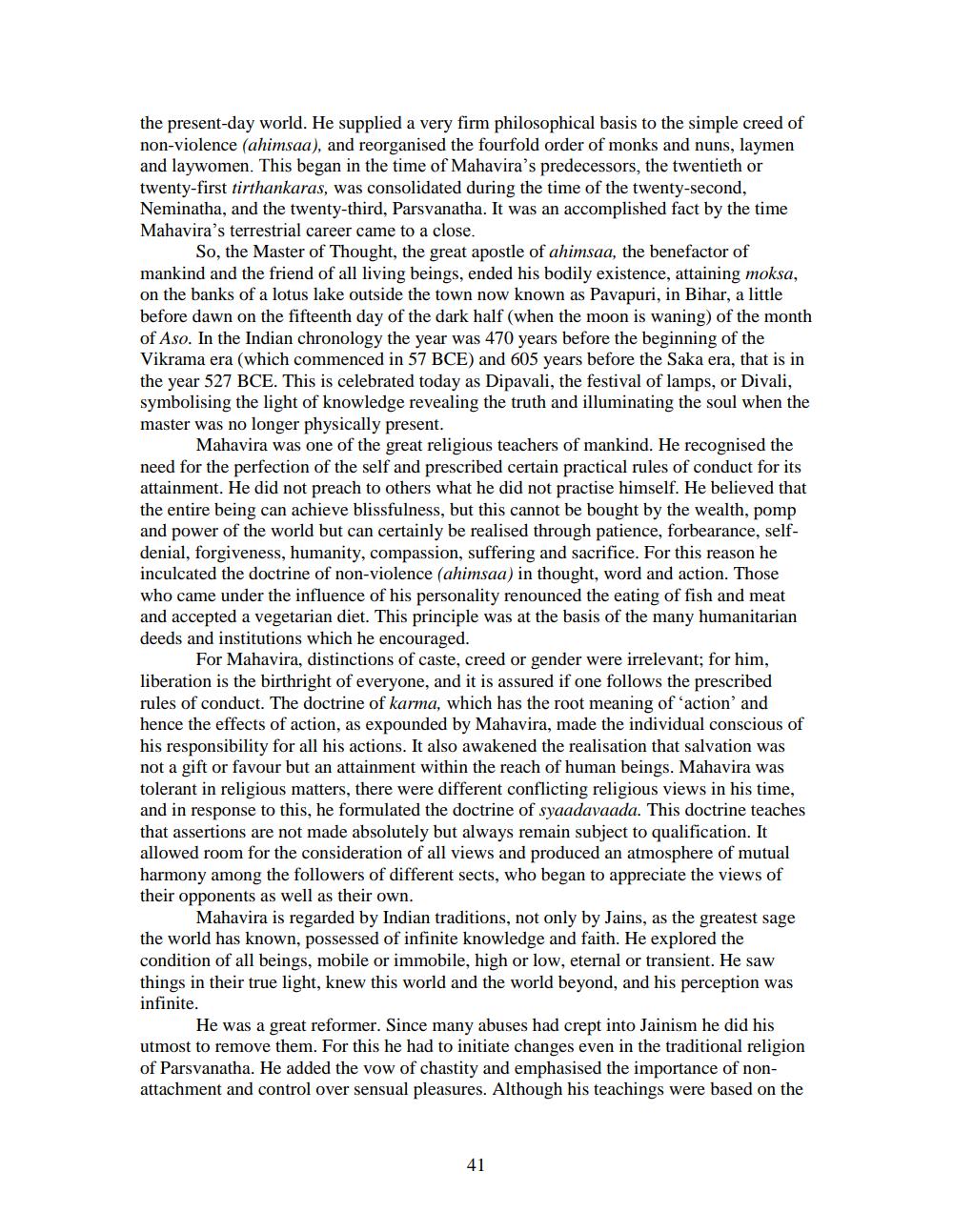________________
the present-day world. He supplied a very firm philosophical basis to the simple creed of non-violence (ahimsaa), and reorganised the fourfold order of monks and nuns, laymen and laywomen. This began in the time of Mahavira's predecessors, the twentieth or twenty-first tirthankaras, was consolidated during the time of the twenty-second, Neminatha, and the twenty-third, Parsvanatha. It was an accomplished fact by the time Mahavira's terrestrial career came to a close.
So, the Master of Thought, the great apostle of ahimsaa, the benefactor of mankind and the friend of all living beings, ended his bodily existence, attaining moksa, on the banks of a lotus lake outside the town now known as Pavapuri, in Bihar, a little before dawn on the fifteenth day of the dark half (when the moon is waning) of the month of Aso. In the Indian chronology the year was 470 years before the beginning of the Vikrama era (which commenced in 57 BCE) and 605 years before the Saka era, that is in the year 527 BCE. This is celebrated today as Dipavali, the festival of lamps, or Divali, symbolising the light of knowledge revealing the truth and illuminating the soul when the master was no longer physically present.
Mahavira was one of the great religious teachers of mankind. He recognised the need for the perfection of the self and prescribed certain practical rules of conduct for its attainment. He did not preach to others what he did not practise himself. He believed that the entire being can achieve blissfulness, but this cannot be bought by the wealth, pomp and power of the world but can certainly be realised through patience, forbearance, selfdenial, forgiveness, humanity, compassion, suffering and sacrifice. For this reason he inculcated the doctrine of non-violence ahimsaa) in thought, word and action. Those who came under the influence of his personality renounced the eating of fish and meat and accepted a vegetarian diet. This principle was at the basis of the many humanitarian deeds and institutions which he encouraged.
For Mahavira, distinctions of caste, creed or gender were irrelevant; for him, liberation is the birthright of everyone, and it is assured if one follows the prescribed rules of conduct. The doctrine of karma, which has the root meaning of 'action and hence the effects of action, as expounded by Mahavira, made the individual conscious of his responsibility for all his actions. It also awakened the realisation that salvation was not a gift or favour but an attainment within the reach of human beings. Mahavira was tolerant in religious matters, there were different conflicting religious views in his time, and in response to this, he formulated the doctrine of syaadavaada. This doctrine teaches that assertions are not made absolutely but always remain subject to qualification. It allowed room for the consideration of all views and produced an atmosphere of mutual harmony among the followers of different sects, who began to appreciate the views of their opponents as well as their own.
Mahavira is regarded by Indian traditions, not only by Jains, as the greatest sage the world has known, possessed of infinite knowledge and faith. He explored the condition of all beings, mobile or immobile, high or low, eternal or transient. He saw things in their true light, knew this world and the world beyond, and his perception was infinite.
He was a great reformer. Since many abuses had crept into Jainism he did his utmost to remove them. For this he had to initiate changes even in the traditional religion of Parsvanatha. He added the vow of chastity and emphasised the importance of nonattachment and control over sensual pleasures. Although his teachings were based on the
41




